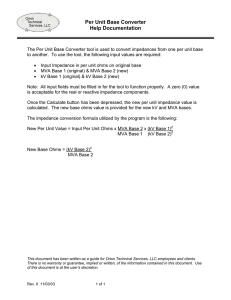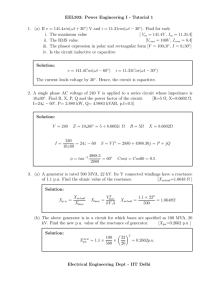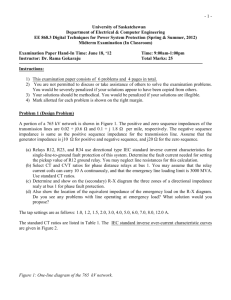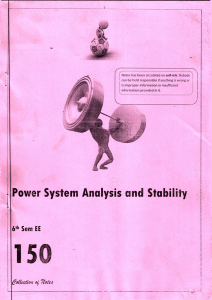section a section-b - PES College of Engineering
advertisement
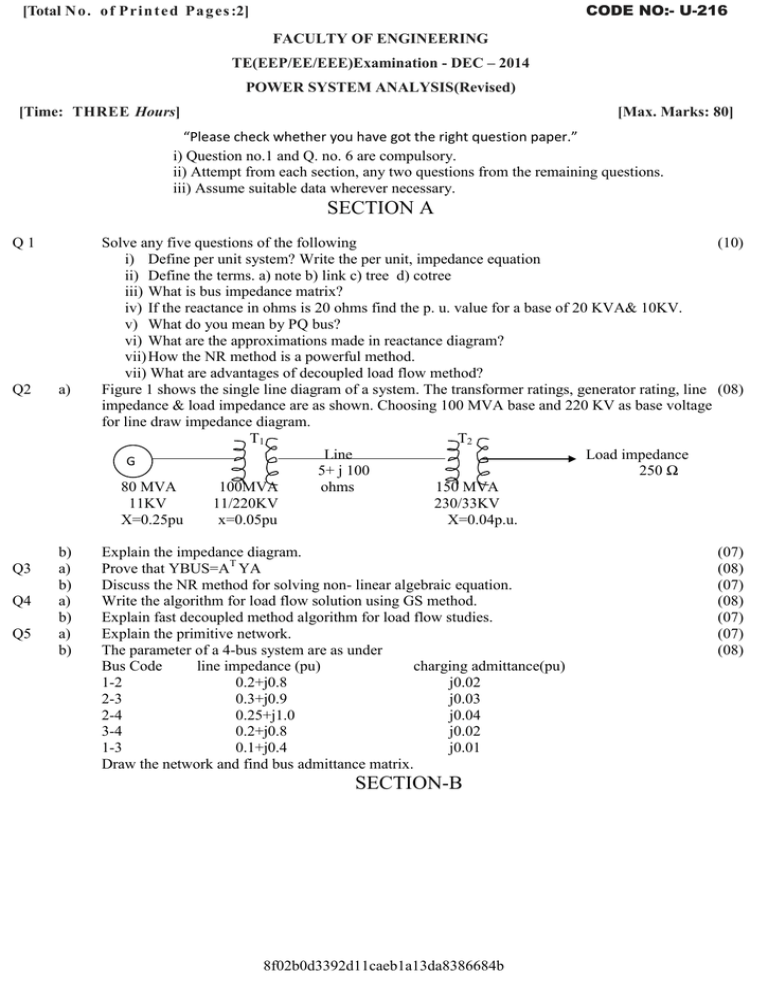
CODE NO:- U-216 [Total N o . o f Pri n t e d Pa g es :2] FACULTY OF ENGINEERING TE(EEP/EE/EEE)Examination - DEC – 2014 POWER SYSTEM ANALYSIS(Revised) [Time: THREE Hours] [Max. Marks: 80] “Please check whether you have got the right question paper.” i) Question no.1 and Q. no. 6 are compulsory. ii) Attempt from each section, any two questions from the remaining questions. iii) Assume suitable data wherever necessary. SECTION A Q1 Q2 Q3 Q4 Q5 a) b) a) b) a) b) a) b) Solve any five questions of the following (10) i) Define per unit system? Write the per unit, impedance equation ii) Define the terms. a) note b) link c) tree d) cotree iii) What is bus impedance matrix? iv) If the reactance in ohms is 20 ohms find the p. u. value for a base of 20 KVA& 10KV. v) What do you mean by PQ bus? vi) What are the approximations made in reactance diagram? vii) How the NR method is a powerful method. vii) What are advantages of decoupled load flow method? Figure 1 shows the single line diagram of a system. The transformer ratings, generator rating, line (08) impedance & load impedance are as shown. Choosing 100 MVA base and 220 KV as base voltage for line draw impedance diagram. T1 T2 Line Load impedance G 5+ j 100 250 Ω 80 MVA 100MVA ohms 150 MVA 11KV 11/220KV 230/33KV X=0.25pu x=0.05pu X=0.04p.u. Explain the impedance diagram. Prove that YBUS=AT YA Discuss the NR method for solving non- linear algebraic equation. Write the algorithm for load flow solution using GS method. Explain fast decoupled method algorithm for load flow studies. Explain the primitive network. The parameter of a 4-bus system are as under Bus Code line impedance (pu) charging admittance(pu) 1-2 0.2+j0.8 j0.02 2-3 0.3+j0.9 j0.03 2-4 0.25+j1.0 j0.04 3-4 0.2+j0.8 j0.02 1-3 0.1+j0.4 j0.01 Draw the network and find bus admittance matrix. SECTION-B 8f02b0d3392d11caeb1a13da8386684b (07) (08) (07) (08) (07) (07) (08) Q6 Q7 a) b) Q8 a) b) Solve any five questions of the following. i) What is need of stack bus? ii) What is the need for short circuit studies? iii) What is meant by doubling effect? iv) What are the main factors to be considered to select a circuit breaker? v) Define short circuit interrupting MVA of a circuit breaker. vi) What is difference between the L-L and L-L-G fault? vii) What is momentary current rating of circuit breaker? How it is estimated. viii) How symmetrical faults are analyzed? Expalin the phenomenon of trausients on a transmission line with waveform. A generating station A has a short circuit capacity of 1000 MVA. Another station B has a short circuit capacity of 650 MVA, they are operating at 11KV. Find the short circuit MVA by taking 100 MVA as base and 11KV as base values. If station A&B are interconnected by a cable of 0.50 ohms reactance per phase. Assume 3 fault at bus A. Explain the zero sequence network of transformer 1) 2) - (10) (07) (08) (07) Figures show a power system network. Draw zero sequence networks. The system data as under. (08) G1: 50 MVA, 11KV,Xo=0.08pu T1 : 50 MVA, 11/220 KV,Xo=0.1pu G2: 30 MVA, 11KV, Xo=0.07pu. T2=30 MVA, 11/220 KV, Xo=0.09pu Zero sequence reactance of line is 555.6 ohms. Choose base of 50 MVA, 11KV base in generator G1 220 KV Line G1 111 1 G2 3Ω Fig2 Q9 a) b) Q10 a) b) Derive an expression to determine fault current for line to line fault and draw the sequence (08) network. A 3 11KV, 20 MVA generators with positive, negative and zero sequence reactances as 0.4 pu, (07) 0.4 pu and 0.1pu respectively, is ground through a reactance of 0.6 Ω calculate the fault current for a single line to ground fault? Explain the open conductor faults. (07) Explain briefly the static security analysis at control centers. (08) 8f02b0d3392d11caeb1a13da8386684b
